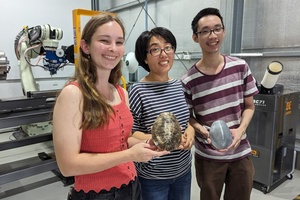This rich imagery resonated with us, and we felt the need to expand on the article further to consider not just the implications for preservice teachers but the perfect storm we can see on the horizon for the sector more broadly.
Professional experience (also known as placement) involves preservice teachers learning from experienced teachers in school or prior-to-school settings. As academics from the Professional Experience field around Australia (NADPE), we are often at the intersection of preservice teachers, schools, regulatory bodies, and university leadership.
In some ways, we are like the meteorologists in the field. We are privy to diverse information sources, which we analyse to predict trends, climatic changes and potential impacts of these events.
Today, we are raising the alarm of a perfect storm, not to cause panic, but as an early alert to protect those involved and begin planning for future disaster relief.
What are the current conditions?
While it is well documented that there is a current teacher shortage in Australia, the impact of this on professional experience and preservice teachers is not well documented.
However, we see a pattern of storms increasing in regularity and intensity. Across Australia, we see a rise in:
1. The employment of preservice teachers with limited authority/registration to teach;
2. A process of fast-tracking preservice teachers to career entry, such as those outlined by the new government;
3. Increasing difficulty in securing professional experience placements for preservice teachers with experienced and knowledgeable mentor teachers.
This approach – to give preservice teachers access to authentic teaching experiences to mitigate some of the pandemic’s impacts – seems logical. Unfortunately, such an approach focuses on the current storm, not the climatic conditions behind it or those ahead.
Schools have also taken on the brunt of the storms without warning, and the long-term impact is just starting to reveal itself.
We have witnessed first-hand how schools have done everything in their power to prioritise their students’ health, wellbeing, and education standards. Similarly, concerning issues exist for preservice teachers.
Around the world, preservice teachers have experienced disrupted study because of the pandemic, with shortened, simulated and irregular placements alongside conditions that have also impacted their engagement in coursework.
Many students have not seen a complete teaching, learning and assessment cycle within the classroom nor witnessed and benefitted from being mentored by highly experienced colleagues.
Previously, these more experienced teachers and leaders would have been mentors, guiding preservice teachers and available for the induction and support that underpins the transition to the profession.
However, they are now working alongside their preservice teacher colleagues who are balancing the demands of their first full-time teaching appointment with full-time university study.
What severe weather can we expect?
We are alarmed at the speed of the current storm and the potential fallout for initial teacher education. Under-prepared and unregistered teachers cannot be well supported within settings grappling with the fallout of major issues experienced during the pandemic.
Nor can they be expected to perform as highly effective graduate teachers when they are drawing on disrupted university preparation and limited placements.
The weather will get harder to predict for many of these fast-tracked and under-prepared teachers, leaving them vulnerable to burnout and early separation from the profession.
Such conditions, combined with the fallout of fast-tracking large numbers of preservice teachers this year, may mean fewer graduates for next year. The forecast shows that this is a long-term trend and leaves teacher education and schools vulnerable to the next storm front.
What will be required to manage the disaster?
Universities are caught having to implement a shortcut, quick-fix policy decision or programs designed by others without our views being sought.
This is evidenced in the recent NSW Upper House Education Committee Inquiry into the teacher shortage crisis that calls for open online submissions from parents, teachers, principals and public members to share their experiences and concerns, which pays no recognition or acknowledgement of those charged with preparing future teachers.
The clean-up requires all stakeholders to contribute to disaster mitigation, and the meteorologists must be brought back into the control room.
Regulators, employers, school leaders, teachers and preservice teachers must engage with the weather warning and recognise that the approaching storms need a coordinated effort and long-term planning and even a rethink of teacher education and the responsiveness of modification in response.
It is not in our nature to ignore an approaching storm. Equally, we are all attuned to the frequency of severe storms and the climatic trends that create them. The weather and climate weigh heavily on our collective consciousness because we know they shape our future, whether we like it or not.
Importantly, within the context of Professional Experience in initial teacher education, the meteorologists’ (teacher educators and educational researchers) reading of the approaching weather systems is not being sought.
At best, they have been given the day off. At worst, their concerns about the long-range forecast are being sidelined or silenced.
Collectively, we need to be reorientating our focus to preparing high-quality teaching graduates.
So, we again stress that giving our preservice teachers an umbrella to go out into this storm is not sustainable, justifiable or in anyone’s best interest.
References
Morrison, C., Bentely, B., Clifton, J., & Ledger, S. (2022, July 33). Growing numbers of unqualified teachers are being sent into classrooms – this is not the way to ‘fix’ the teacher shortage. The Conversation. https://edhq.co/3p2d5e1














